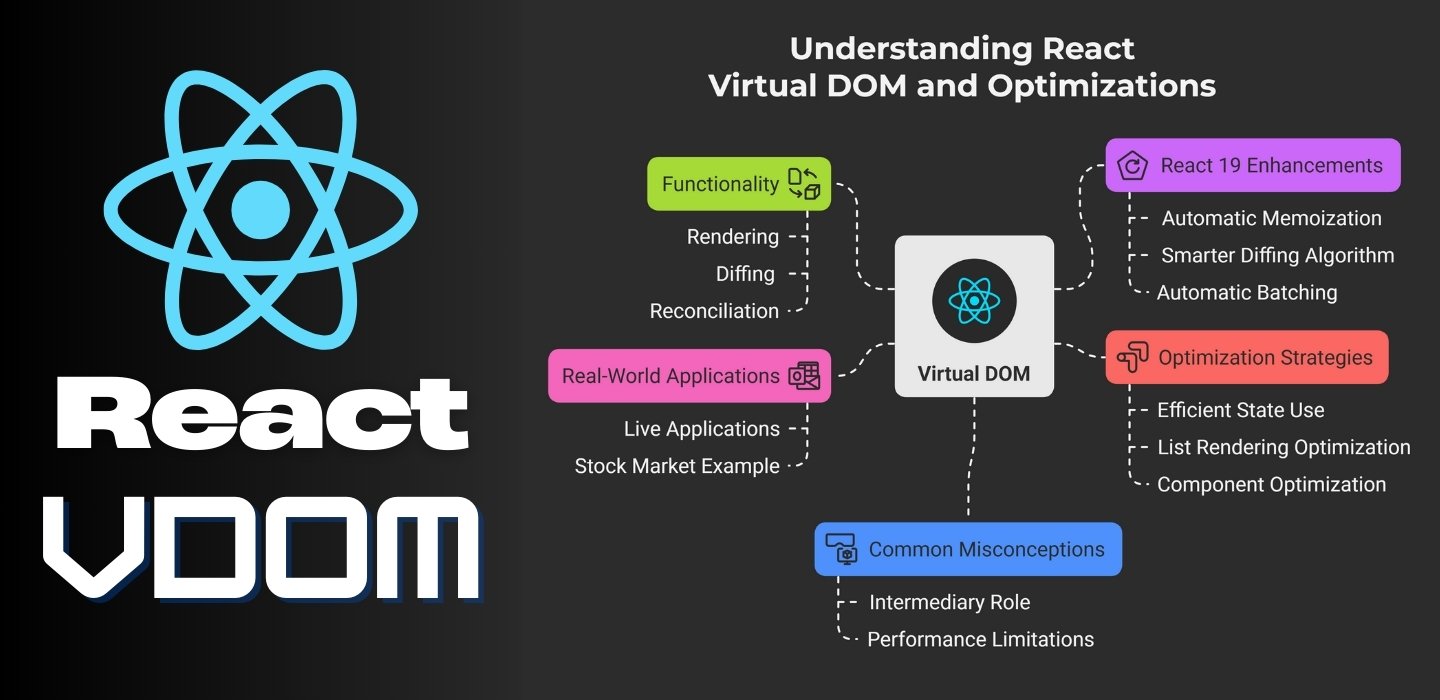Table Of Contents

What is the Virtual DOM, and How Does It Work
React is widely known for its performance, but what makes it so efficient? The answer lies in how it manages UI updates using the Virtual DOM. Instead of modifying the actual DOM directly, which can be slow and inefficient, React takes a smarter approach by leveraging a Virtual DOM to optimize rendering.
Why Does the Virtual DOM Exist
The real DOM is a structured representation of a webpage. It allows JavaScript to dynamically update elements, styles, and attributes. However, frequent direct manipulation of the real DOM can significantly slow down performance due to expensive layout recalculations, reflows, and repaints.
The Virtual DOM serves as a lightweight abstraction, ensuring that only necessary updates reach the real DOM. By making these optimizations, React minimizes unnecessary re-renders, leading to a faster and more responsive user experience.
How the Virtual DOM Works
Rendering to the Virtual DOM
When a state or prop changes in a React component, React does not update the real DOM immediately. Instead, it first updates a Virtual DOM representation of the UI. This process is efficient because modifying JavaScript objects in memory is significantly faster than updating the actual DOM elements.
Diffing Algorithm – Identifying Changes
Once a new Virtual DOM is generated, React compares it with the previous version to determine what has changed. This process, called diffing, allows React to precisely identify the smallest set of updates needed instead of re-rendering the entire UI.
Reconciliation – Updating the Real DOM
After detecting the differences, React applies only the necessary changes to the real DOM. This step is known as reconciliation. Instead of replacing the entire DOM tree, React surgically updates only the elements that require modification. This significantly reduces the workload on the browser, improving rendering efficiency.
Why the Virtual DOM is Faster
Updating the real DOM is costly because every change forces the browser to:
- Recalculate styles and layouts
- Move elements within the UI
- Repaint sections of the page
React’s Virtual DOM prevents unnecessary operations by:
- Batching multiple updates into a single optimized update cycle
- Skipping unnecessary changes that do not impact the UI
- Minimizing direct interaction with the browser’s rendering engine
This results in smoother animations, faster page transitions, and an overall better user experience.
React 19 Enhancements in Virtual DOM Processing
Automatic Memoization
React 19 introduces automatic memoization, reducing the need for developers to manually optimize renders using useMemo and useCallback. The new compiler automatically optimizes function executions, ensuring that unnecessary recalculations are avoided.
Smarter Diffing Algorithm
The improved diffing algorithm in React 19 allows React to process UI changes even more efficiently. This results in faster state updates and more precise rendering, minimizing performance bottlenecks in complex applications.
Automatic Batching of Updates
React 19 ensures that multiple state updates happening within the same event loop are batched together into a single update cycle. This prevents excessive re-renders and keeps the UI responsive, even during rapid state changes.
Real-World Use Case – Virtual DOM in Action
Consider a live stock market application that updates real-time prices for thousands of stocks. Without the Virtual DOM, every stock price update would trigger a complete re-render of the UI, causing unnecessary computations and slowing down interactions.
With the Virtual DOM, React efficiently:
- Identifies which stocks have updated
- Updates only those specific elements in the real DOM
- Keeps the rest of the UI unchanged for optimal performance
This approach allows real-time applications to handle frequent updates without affecting user experience.
Common Misconceptions About the Virtual DOM
The Virtual DOM Replaces the Real DOM
The Virtual DOM is not a replacement for the real DOM. It is an intermediary that optimizes UI updates by reducing direct interactions with the browser’s rendering engine. The final updates are still applied to the real DOM, but in a more efficient manner.
The Virtual DOM Always Improves Performance
While the Virtual DOM generally enhances rendering speed, poor implementation practices such as excessive state updates, unnecessary re-renders, and incorrect key usage in lists can still degrade performance. Understanding how React manages state and rendering cycles is crucial for maximizing efficiency.
Optimizing Applications for Better Virtual DOM Performance
Use State Efficiently
Avoid deep object structures in the state that trigger unnecessary updates. Instead, use shallow state objects and update only the necessary parts of the component tree.
Optimize List Rendering with Unique Keys
React relies on keys to track changes in lists. Using non-unique or unstable keys can cause unnecessary re-renders, reducing efficiency. Always use unique identifiers instead of array indices.
Use React.memo for Component Optimization
React.memo prevents unnecessary re-renders by ensuring that components only update when their props change. This is especially useful for optimizing functional components that rely on external data.
Final Thoughts
The Virtual DOM is one of React’s most powerful optimization mechanisms, enabling efficient updates and smooth UI interactions. With React 19 improvements, applications can now achieve even better performance through automatic memoization, smarter reconciliation, and enhanced state batching.
For developers, understanding how the Virtual DOM works is essential for building scalable, high-performance applications. By leveraging best practices and React’s built-in optimizations, it is possible to create highly efficient web applications that maintain smooth user experiences.











